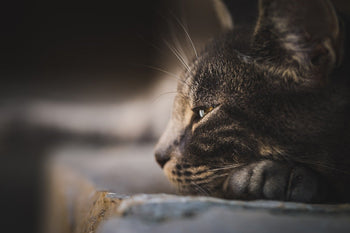Cats are known for their playful and affectionate behavior, but sometimes their love bites can be painful and unwanted. While it's natural for cats to use their teeth and claws during play, it's important to train them to avoid biting humans.This article will provide tips and strategies for training your cat to avoid love bites, improving your human-animal bond and making playtime more enjoyable.
Understanding Cat Love Bites
Before diving into training techniques, it's important to understand why cats love to bite. Love bites are a form of communication for cats, often used during play or affection. While most love bites are harmless, some cats may bite too hard or too often, causing pain or injury. Additionally, cats may bite out of fear or aggression, which requires a different approach to training.
The Impact of Love Bites on Human-Animal Bond
While love bites may seem harmless, they can have a negative impact on the human-animal bond. If a cat's biting behavior is not addressed, it may lead to fear or avoidance of the cat, causing a breakdown in the relationship. By training your cat to avoid love bites, you can strengthen your bond and create a more positive and enjoyable relationship.
Training Your Cat to Avoid Love Bites

Key Takeaways
- Love bites are a form of communication for cats, but can sometimes be painful or unwanted.
- Training your cat to avoid love bites can improve your human-animal bond and make playtime more enjoyable.
- Addressing biting behavior early can prevent a breakdown in the human-animal relationship.
Understanding Cat Love Bites
Cats are known for their affectionate behavior towards their owners. However, sometimes their love can be a bit too much to handle, especially when they start biting. Understanding the reasons behind love bites can help cat owners train their cats to avoid this behavior.
Defining Love Bites
Love bites, also known as play bites, are usually gentle bites that cats give to their owners during playtime. These bites are different from aggressive bites, which are usually harder and more painful. Love bites are a way for cats to show their affection, but they can become a problem if they are too rough or frequent.
Types of Love Bites
There are different types of love bites that cats can give. Some cats may gently nibble on their owner's fingers or toes, while others may bite harder. Cats may also give love bites to other cats or animals, as a way of showing their affection.
Reasons Behind Love Bites
There are several reasons why cats may give love bites. One of the most common reasons is that they are playing and showing their affection. Another reason may be that they are overstimulated, and the biting is a way for them to release their energy. Some cats may also give love bites as a way of marking their territory.
To prevent love bites, cat owners can train their cats to play gently and avoid rough play. They can also provide their cats with toys and scratching posts to redirect their energy. If a cat continues to give love bites despite training, it may be a good idea to consult a veterinarian to rule out any underlying health issues.
Related Posts:
The Impact of Love Bites on Human-Animal Bond
Love bites, also known as play bites, are a common behavior in cats. However, these bites can have negative consequences on the human-animal bond. It is important for cat owners to understand the impact of love bites on their relationship with their feline friend.
Negative Consequences
Love bites may seem harmless, but they can cause physical harm to humans. Cats have sharp teeth and claws that can break the skin, leading to infections. In addition, love bites can cause emotional harm, as they can be painful and scary for humans.
Love bites can also lead to a breakdown in communication between cats and humans. If a cat is constantly biting their owner, the owner may become fearful and avoid interacting with the cat. This can lead to a lack of trust and a strained relationship.
Importance of Boundaries
Establishing boundaries is crucial for preventing love bites. Cats need to understand what behaviors are acceptable and what behaviors are not. It is important for cat owners to set clear boundaries and consistently enforce them.
One effective way to establish boundaries is through positive reinforcement training. By rewarding good behavior and ignoring bad behavior, cats can learn what is expected of them. This can help prevent love bites and improve the human-animal bond.
Examples of Strained Relationships
Love bites can lead to strained relationships between cats and their owners. For example, if a cat is constantly biting their owner, the owner may become fearful and avoid interacting with the cat. This can lead to a lack of trust and a breakdown in communication.
In extreme cases, love bites can lead to the surrender of the cat to a shelter or rescue organization. This can be traumatic for the cat and can lead to long-term emotional issues.
In conclusion, love bites can have a negative impact on the human-animal bond. It is important for cat owners to understand the consequences of this behavior and take steps to prevent it. By establishing clear boundaries and using positive reinforcement training, cat owners can improve their relationship with their feline friend.
Training Your Cat to Avoid Love Bites
Practical Training Tips
Cats are known for their affectionate nature, but sometimes their love bites can be painful. To train your cat to avoid love bites, it is important to understand their behavior. Cats often bite when they are overstimulated, anxious, or in pain. By recognizing these triggers, you can take steps to prevent love bites.
One practical training tip is to avoid petting your cat's belly or paws, as these are sensitive areas that can trigger biting. Instead, focus on petting their head, chin, and back. If your cat starts to show signs of overstimulation, such as twitching their tail or flattening their ears, stop petting them and give them space.
Positive Reinforcement Methods
Positive reinforcement is a powerful tool for training cats. When your cat displays good behavior, such as refraining from biting, reward them with treats or praise. This will encourage them to repeat the behavior in the future.
One effective positive reinforcement method is clicker training. This involves using a clicker to make a distinct sound when your cat displays good behavior, followed by a treat. Over time, your cat will associate the clicker with positive reinforcement and will be more likely to exhibit good behavior.
Step-By-Step Behavior Redirection
If your cat continues to exhibit love biting behavior, it may be necessary to redirect their behavior. One step-by-step behavior redirection method is to provide your cat with a toy or scratching post to redirect their biting behavior.
When your cat starts to bite, gently redirect their attention to the toy or scratching post. Once they start to use the toy or scratching post, reward them with treats or praise. With consistent redirection and positive reinforcement, your cat will learn to associate biting with the toy or scratching post instead of your hands or feet.
By using practical training tips, positive reinforcement methods, and step-by-step behavior redirection, you can train your cat to avoid love bites. Remember to be patient and consistent in your training, and always reward good behavior.
Conclusion
Training a cat to avoid love bites can be a challenging task, but it is not impossible. By using positive reinforcement techniques, such as rewarding good behavior and ignoring bad behavior, cat owners can teach their cats to express affection in a non-aggressive way.
It is important to remember that cats are independent creatures and may not always respond to training as expected. Consistency and patience are key when working with cats. It is also important to understand that love bites may be a natural behavior for some cats and cannot always be completely eliminated.
In addition to training, providing cats with appropriate outlets for their natural behaviors, such as scratching posts and toys, can help reduce the likelihood of love bites. Regular playtime and exercise can also help reduce stress and prevent unwanted behaviors.
Overall, training a cat to avoid love bites requires dedication and a deep understanding of feline behavior. With patience and consistency, cat owners can help their furry friends express their affection in a safe and non-aggressive way.
Frequently Asked Questions
How can I differentiate between a love bite and an aggressive bite from my cat?
Love bites are usually gentle and non-painful nibbles that cats use to show their affection. On the other hand, aggressive bites are painful and can cause injury. If your cat's bite is accompanied by hissing, growling, or other signs of aggression, it is likely an aggressive bite.
What are effective methods to discourage my cat from giving love bites?
One effective method is to redirect your cat's biting behavior by offering them a toy to play with or a treat to distract them. You can also teach your cat that biting is not acceptable by using positive reinforcement training techniques.
Why does my cat bite me softly when I'm petting them?
Cats may bite softly during moments of affection as a way of expressing their love or excitement. It is important to understand your cat's body language and recognize when they are becoming overstimulated to prevent them from biting too hard.
Can allowing my cat to give love bites lead to behavioral issues?
Allowing your cat to give love bites in moderation is generally not a problem. However, if your cat's biting behavior becomes excessive or painful, it may be a sign of underlying behavioral issues that require attention.
What steps should I take if my cat's love bites become painful or too frequent?
If your cat's love bites become painful or too frequent, it is important to discourage the behavior by redirecting their attention or using positive reinforcement training techniques. You can also consult with a veterinarian or a professional animal behaviorist for further guidance.
How can I understand and respond to my cat's biting behavior during moments of affection?
Understanding your cat's body language and recognizing when they are becoming overstimulated is key to preventing painful bites. Responding to your cat's biting behavior by redirecting their attention or using positive reinforcement training techniques can also help to discourage the behavior.
Related Posts:















